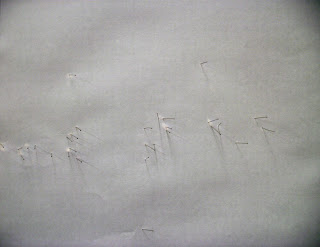I scanned one of my drawings and converted it to index colour in photoshop, having reduced the size to 80x90 pixels. 80x90 pixels is the standard sampling size.
Some areas are slightly 'untidy', this is normally fixed; however I like this style as it gives interesting texture when working with two different yarns.
For example, Lycra will pull in, leaving the other yarn to ruche and contort.
Sample one: mohair and lycra. (disconnected digital stitch roller)
Sample two: mohair and felting yarn.
Sample three: mohair and stronger lycra (disconnected digital stitch roller)
Sample four: mohair and elastic
S1 (file name) Stitch 50 (tension)
Structure: Two colour ladder-back
I used one 'control' yarn and four different yarns with different properties. By using one yarn the same every time I was able to assess how the lycras, elastic and felting yarn affected the fabric.
See sample section 012















































































